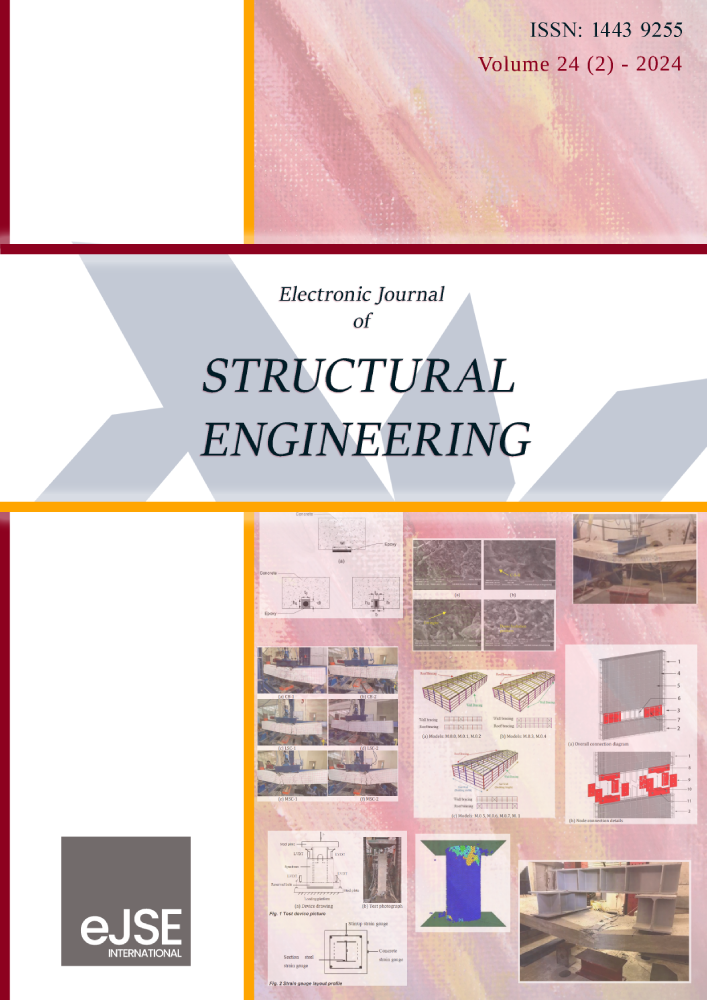Enhancement of Concrete Microstructure using Graphene Oxide as a Cement Additive: An Experimental Study
DOI:
https://doi.org/10.56748/ejse.24526Keywords:
Concrete, Compressive strength, Flexural strength, Graphene oxide, Microstructure analysis, Mechanical properties enhancement, WorkabilityAbstract
The current study investigates the graphene oxide’s (GO) effect on the mechanical properties of standard concrete. To compare, conventional concrete was designed to attain a compressive strength of 30 MPa, and GO was added to create graphene oxide concrete. The workability and compressive strength of various concrete mixtures were evaluated, and the best mixture, GC2 (0.2% GO), demonstrated a compressive strength of 42 MPa and a flexural strength of 6.0 MPa after 28 days of curing. Additional analysis of GC2 using SEM, EDAX, and XRD revealed a more compact microstructure of hydration products. The results of this study suggest that the mechanical properties of concrete are enhanced by the inclusion of graphene oxide (GO).
Downloads
References
Akarsh, P. K., Marathe, S., & Bhat, A. K. (2021). Influence of graphene oxide on properties of concrete in the presence of silica fumes and M-sand. Construction and Building Materials, 268, 121093. DOI: https://doi.org/10.1016/j.conbuildmat.2020.121093
Balaji, S., & Swathika, A. (2022). Review on mechanical and microstructural properties of cementitious composites with graphene oxide. Materials Today: Proceedings, 50, 2280–2287. DOI: https://doi.org/10.1016/j.matpr.2021.09.544
Bureau of Indian Standards (BIS) (2016). IS 383:2016. Coarse and Fine Aggregate for Concrete Specification. Indian Standard Code, Third edit (January).
Bureau of Indian Standards (BIS). (2000). IS 456:2000: Plain and Reinforced Concrete - Code of Practice. Indian Standards, (July).
Bureau of Indian Standards (BIS) (2004). IS 516:1959 Method of Tests for Strength of Concrete. IS: 516 - 1959 (Reaffirmed 2004).
Bureau of Indian Standards (BIS). (1999). IS 9103: 1999, (1999). Specification for Concrete Admixtures BIS. Bureau of Indian Standards, New Delhi.
Bureau of Indian Standards (BIS) (2019). BIS 10262-2019. (2019). BIS 10262 -2019, Concrete Mix Proportioning- Guidelines. Bureau of Indian Standards (BIS), Second Rev (January).
Bureau of Indian Standards (BIS). (2013). IS 12269: 2013 Ordinary Portland Cement, 53 grade specification. Indian Standards, March.
Chuah, S., Pan, Z., Sanjayan, J. G., Wang, C. M., & Duan, W. H. (2014). Nano reinforced cement and concrete composites and new perspective from graphene oxide. Construction and Building Materials, 73, 113–124. DOI: https://doi.org/10.1016/j.conbuildmat.2014.09.040
Devi, S. C., & Khan, R. A. (2020). Effect of graphene oxide on mechanical and durability performance of concrete. Journal of Building Engineering, 27, 101007. DOI: https://doi.org/10.1016/j.jobe.2019.101007
Ginigaddara, T., Ekanayake, J. C., Mendis, P., Devapura, P., Liyanage, A. D., & Vaz-Serra, P. (2022). An Introduction to High Performance Graphene Concrete. Electronic Journal of Structural Engineering, 22(3). DOI: https://doi.org/10.56748/ejse.223553
Gong, K., Pan, Z., Korayem, A. H., Qiu, L., Li, D., Collins, F., Wang, C. M., & Duan, W. H. (2015). Reinforcing Effects of Graphene Oxide on Portland Cement Paste. Journal of Materials in Civil Engineering, 27(2). DOI: https://doi.org/10.1061/(ASCE)MT.1943-5533.0001125
Kang, D., Seo, K. S., Lee, H. Y., & Chung, W. (2017). Experimental study on mechanical strength of GO-cement composites. Construction and Building Materials, 131. DOI: https://doi.org/10.1016/j.conbuildmat.2016.11.083
Lee, S. J., Jeong, S. H., Kim, D. U., & Won, J. P. (2020). Graphene oxide as an additive to enhance the strength of cementitious composites. Composite Structures, 242. DOI: https://doi.org/10.1016/j.compstruct.2020.112154
Li, W., Li, X., Chen, S. J., Long, G., Liu, Y. M., & Duan, W. H. (2017). Effects of Nanoalumina and Graphene Oxide on Early-Age Hydration and Mechanical Properties of Cement Paste. Journal of Materials in Civil Engineering, 29(9). DOI: https://doi.org/10.1061/(ASCE)MT.1943-5533.0001926
Li, X., Liu, Y. M., Li, W. G., Li, C. Y., Sanjayan, J. G., Duan, W. H., & Li, Z. (2017). Effects of graphene oxide agglomerates on workability, hydration, microstructure, and compressive strength of cement paste. Construction and Building Materials, 145. DOI: https://doi.org/10.1016/j.conbuildmat.2017.04.058
Lin, C., Wei, W., & Hu, Y. H. (2016). Catalytic behavior of graphene oxide for cement hydration process. Journal of Physics and Chemistry of Solids, 89. DOI: https://doi.org/10.1016/j.jpcs.2015.11.002
Ling, X., Guo, X., Zhong, J., Ma, J., Tang, L., Xing, D., Su, J., & Cong, S. (2022). Investigation of the Effect of Graphene Oxide on the Properties and Microstructure of Clay-Cement Composite Grouting Materials. Materials, 15(5). DOI: https://doi.org/10.3390/ma15051623
Ramirez-Meneses, E., A. Domínguez-Crespo, M., & M. Torres-Huerta, A. (2012). Stabilized Metal Nanoparticles from Organometallic Precursors for Low Temperature Fuel Cells. Recent Patents on Nanotechnology, 7(1), 13–25. DOI: https://doi.org/10.2174/1872210511307010013
Roy, R., Mitra, A., Ganesh, A. T., & Sairam, V. (2018). Effect of Graphene Oxide Nanosheets dispersion in cement mortar composites incorporating Metakaolin and Silica Fume. Construction and Building Materials, 186. DOI: https://doi.org/10.1016/j.conbuildmat.2018.07.135
Silvestre, J., Silvestre, N., & de Brito, J. (2016). Review on concrete nanotechnology. European Journal of Environmental and Civil Engineering, 20(4), 455–485. DOI: https://doi.org/10.1080/19648189.2015.1042070
Somasri, M., & Narendra Kumar, B. (2021). Graphene oxide as Nano material in high strength self-compacting concrete. Materials Today: Proceedings, 43, 2280–2289. DOI: https://doi.org/10.1016/j.matpr.2020.12.1085
Wang, L., Zhang, S., Zheng, D., Yang, H., Cui, H., Tang, W., & Li, D. (2017). Effect of Graphene Oxide (GO) on the Morphology and Microstructure of Cement Hydration Products. Nanomaterials, 7(12), 429. DOI: https://doi.org/10.3390/nano7120429
Zhou, M., Wang, Z., & Wang, X. (2017). Carbon Nanotubes for Sensing Applications. In Industrial Applications of Carbon Nanotubes. DOI: https://doi.org/10.1016/B978-0-323-41481-4.00005-8
Downloads
Published
How to Cite
Issue
Section
License
Copyright (c) 2024 Rajendra Prasad, Nirmala, Sridevi, Madhu , Sharath

This work is licensed under a Creative Commons Attribution 4.0 International License.







